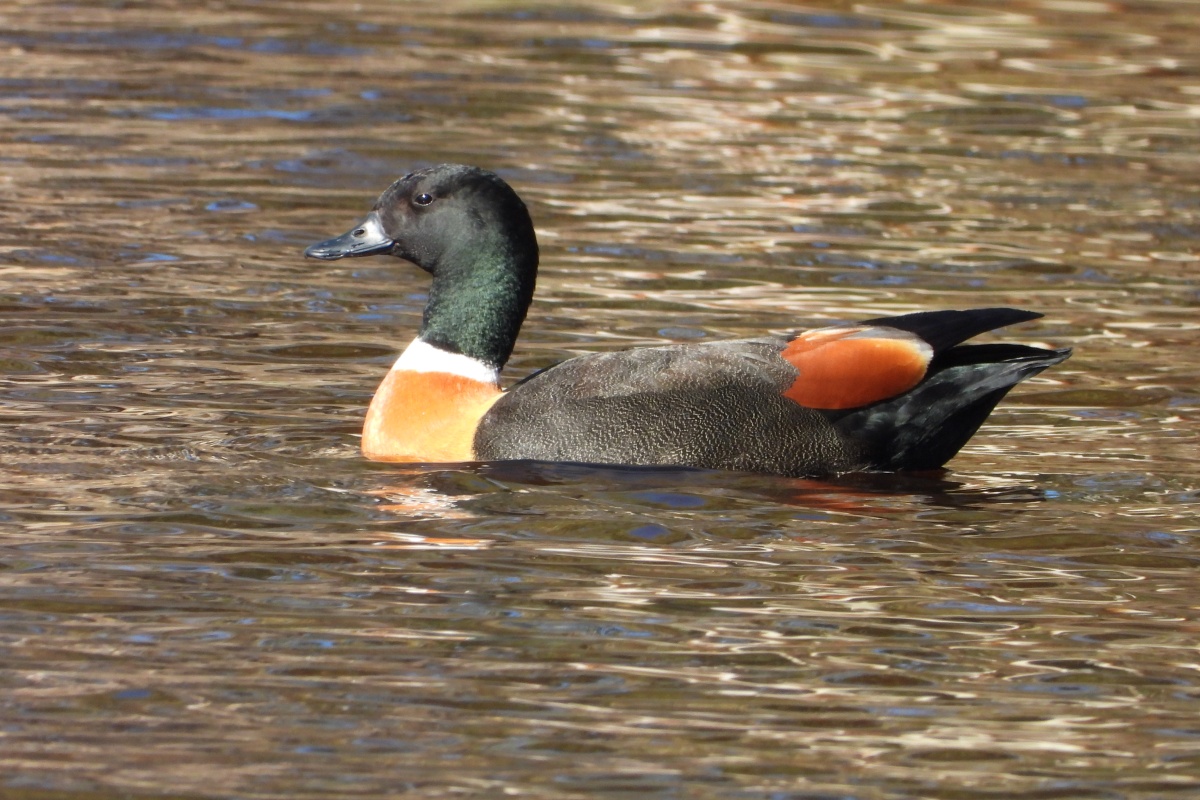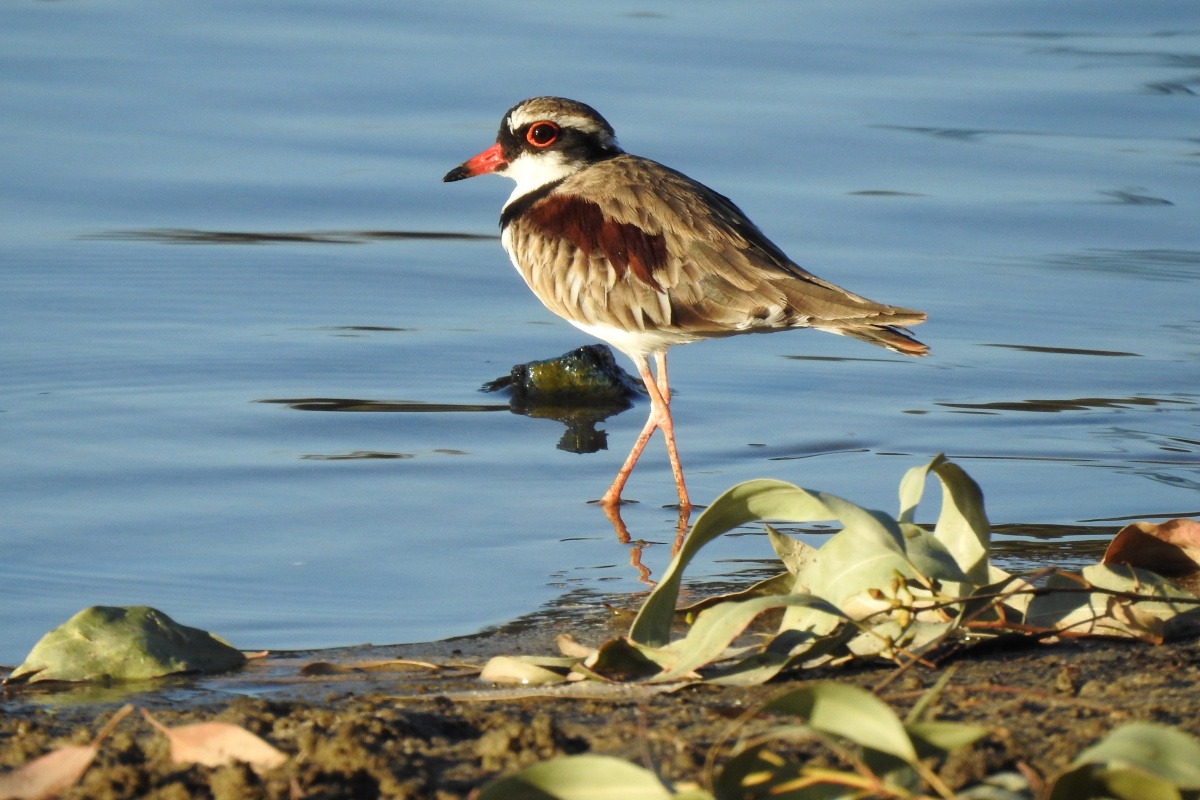Waterbirds are often much easier to see than songbirds because they are usually larger and most of them inhabit the open spaces on or near water in Perth’s ponds, lakes and rivers, including large wetlands such as Bibra Lake, Lake Joondalup or Herdsman Lake. However, of equal importance are all the smaller local parks, reserves and wetlands throughout the State, which provide the birds with important refuges. As the impact of a drying climate takes hold, these various wetlands, small or large, are vital for the birds’ survival.
The term ‘waterbirds’ is a catchall for numerous, very different types of bird, and many people find it hard to differentiate between them. For instance, we recently heard a father tell his young son that a Eurasian coot (Fulica atra) was a duck. A coot is not a duck! In addition, despite what some people presume, not all waterbirds swim. Some only wade at the water’s edge.
SWIMMERS
The most obvious swimmers are the ducks. Often, the first ducks you see on a body of water are Pacific black ducks (Anas superciliosa) and Australian wood ducks (Chenonetta jubata). They are both quite common and both good swimmers. They have webbed feet to help propel them.
Many ducks, when seen from a distance, can appear dark, dull and hard to identify. To make identification even more difficult, the males and females of some waterbirds, such as Australian wood ducks, look different. The female has a light brown head and neck, with eyes highlighted by pale white stripes. The male has a rich dark-brown head and neck.
Another handsome duck, the Australian shelduck (Tadorna tadornoides), also has different markings for the males and females. The females have a white ring round their eyes, and the male is plain.
Grey teals (Anas gracilis) are another common duck that are often confused with other ducks, but they have red eyes, a slate-grey bill and creamy-white cheeks and neck.
Perhaps the plainest duck you may see is the hardhead (Aythya australis). Male hardheads have a distinct white iris, but the females are brown all over and the ducklings have yellow faces and breasts. Interestingly, the legs of the hardhead are placed well back on their bodies, which is excellent for swimming and diving but practically useless for walking on land.
It is important to note that not all birds that swim have webbed feet, and not all birds that swim are ducks.
Australasian grebes (Tachybaptus novaehollandiae), for example, swim like ducks but are not related to ducks, although they’re often with them. They have a ‘now you see me, now you don’t’ attitude, and can quickly dive out of sight and re-appear several metres away. When you see them, you may see the chicks riding on their mother’s back, a delightful sight.
Other birds that swim but aren’t related to either ducks or grebes include little pied cormorants (Microcarbo melanoleucos). Along with Australasian darters (Anhinga novaehollandiae) and little black cormorants (Phalacrocorax sulcirostris), they swim and dive to catch fish and crustaceans from shallow water but unlike ducks do not have waterproofing oils in their feathers, so when they dive they become totally wet through. This reduces their buoyancy, enabling them to stay underwater easily. Australasian darters can swim so low in the water that only the head and neck may be visible, earning them the name ‘snake-bird’. Cormorants and darters often sit on branches stretching out their wings to dry. It’s a common sight on our riverbanks.
What of the birds that can swim but don’t have webbed feet? Two of these are commonly seen. Eurasian coots – with their white face shields – and dusky moorhens (Gallinula tenebrosa) – with their red and yellow beaks. Coots have three flanges on either side of each toe enabling them to push against the water to swim, while dusky moorhens have completely bare toes, but can still swim, just less efficiently.
WADERS
In complete contrast to swimmers are the waterbirds that wade through relatively shallow water hunting for food, such as small fish and crustaceans. Some may drown if they try to swim.
White-faced herons (Egretta novaehollandiae) and little egrets (Egretta garzetta) are examples of two large waders. The egrets are nearly always pure white, while herons generally are grey and white. They both develop beautiful, showy, nuptial plumes during the breeding season. However, there are colour exceptions, and the nankeen night heron (Nycticorax caledonicus) is reddish-brown with yellow legs. During the day it quietly roosts in a shady tree by the waterside.
Egrets and herons stand in the water and hunt by vision, watching for and then pouncing on fish. In contrast, yellow-billed spoonbills (Platalea flavipes) feed by feel. They wade in wetlands moving their spoon-shaped bills from side-to-side along the muddy bottom finding items to eat. When they fly, their necks are straight, in contrast to the herons and egrets that both fly with kinked necks.
Pied stilts (Himantopus leucocephalus), red-necked avocets (Recurvirostra novaehollandiae) and banded stilts (Cladorhynchus leucocephalus) are smaller wading birds, with pied stilts being seen most often. They use their long pink legs for wading in water up to about 30cm deep where they forage for small aquatic invertebrates. You may see them flying with their pink legs trailing behind them, but you won’t see them swim.
A much smaller, but equally fascinating wader, is the black-fronted dotterel (Charadrius melanops). It spends its time at the water’s edge where it can easily be missed because it’s so tiny and well camouflaged. The photograph shows dried gum leaves behind the bird, giving a good scale comparison. Dotterels have a habit of freezing for 15 to 20 seconds before scuttling at high speed for a few metres then repeating the process. It may also bob its head. Why? Because birds have eyes on the side of their heads and bobbing allows them to get around their lack of binocular vision and gain depth perception.
Finally, some waders are very colourful, Australasian swamphens (Porphyrio melanotus) being a perfect example. They are various shades of blue and purple, with brilliant red beaks and shields. They have very long toes enabling them to walk across half-submerged vegetation as they move around the water’s edge looking for juicy shoots to eat. But here is the catch, they can also swim.
There are plenty of fascinating and beautiful waterbirds in Western Australia and many we haven’t included, from black swans (Cygnus atratus), Australian pelicans (Pelecanus conspicillatus) and Australasian shovelers (Spatula rhynchotis) to pink-eared ducks (Malacorhynchus membranaceus) and spotted crakes (Porzana fluminea). Whether swimmers or waders, they are all a pleasure to see. However, they all need our protection and rely on us to preserve our wetlands and to keep our ponds, lakes and rivers healthy.
As individuals, we can care for waterbirds by not feeding them. It’s bad for them to eat carbohydrate-rich food meant for humans. It can lead to malnutrition and disease and cause them to neglect their natural healthy diet. It can also result in the more confident species out-competing timid ones, and this can ultimately displace them, putting the whole ecosystem out of balance. Unused food can also end up in the water, contributing to algal blooms and poor water quality.
Twelve smaller parks to see waterbirds in Perth metro area
This is not an exclusive list, there are others. Please note some may dry out in summer.
- Baigup Wetlands, City of Bayswater
- Ollie Worrell Reserve, High Wycombe, City of Kalamunda
- Broz Park, Helena Valley, Shire of Mundaring
- Lake Jualbup, Shenton Park, City of Subiaco
- Blackadder Wetlands, Viveash, City of Swan
- Gillings Parade Wetlands, Wattle Grove, City of Kalamunda
- Lake Claremont, Town of Claremont
- Kings Meadow Reserve, Guildford, City of Swan
- Tomato Lake, Kewdale, City of Belmont
- Hyde Park Lake, City of Vincent
- Horse Swamp, Whiteman, City of Swan
- Neil McDougall Park, Como, City of South Perth






